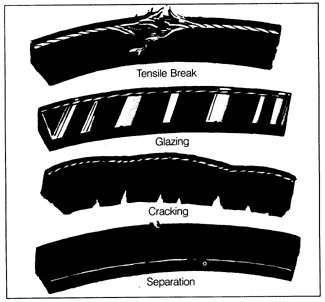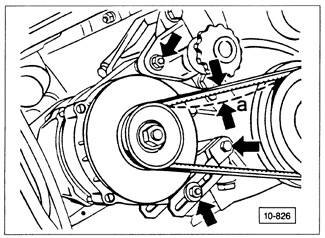Inspecting and AdjustingProper V-belt maintenance, by correcting loose or overtight belts, can extend the life of the belt and the component it drives. Inspect belts with the engine off, and twist the belt to see its sidewalls and bottom. Belt structural damage, glazed or shiny sidewalls caused by a loose belt, or separation caused by oil contamination are all reasons to replace a belt. Some of these faults are illustrated in Fig. 6-3.

V-belt squealing is normally caused by incorrect belt tension (too loose) or by contamination between the belt and pulley. Extremely loud squealing may only be corrected by replacing the belt. Belt dressings should not be used to correct the problem. Many dressings contain oil-based compounds which can soften the rubber and reduce belt life.
Check V-belt tension by checking the amount of deflection when the belt is pressed midway between two pulleys, as shown in Fig. 6-4. Deflection specifications are given in Table j. Alternator V-belt adjustment is described in ELECTRICAL SYSTEM.

Table j. V-Belt Deflection Specifications
The power steering pump and air conditioning compressor V-belts are each adjusted using a tensioning bolt that is part of each of the component mounting brackets. To adjust the tension, loosen the mountings and turn the tensioning bolt, clockwise to tighten the belt or counterclockwise to loosen it. |
